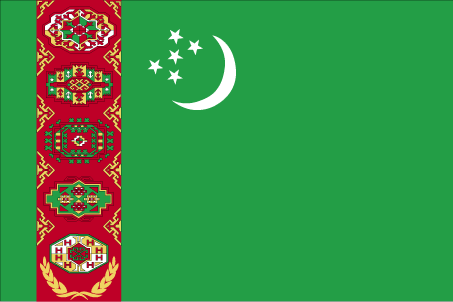
Turkmenistanhas a green flag which displays five carpet designs, one on top of the other and set on a red background. Below the carpet gulls are olive branches, similar to that of the United Nations logo. This red stripe of carpet gulls are positioned near the hoist. On its right, at the upper part, are five stars seemed to be cradled by a waxing crescent facing the hoist and in a slightly upward slant.
The colors red and green are long been venerated by the Turkmen. The crescent moon, predominant in Turkmen symbology, represents the country’s hope for a bright future. The stars represent Turkmenistan’s five provinces: Balkan, Ahal, Lebap, Mary, and Dashhowuz. The five traditional carpet gulls represent the five houses or tribes of Turkmenistan, which in top to bottom as well as the tradition order, are as follows: Teke, Yomut, Arsary, Chowdur, and Saryk. The house of Salor, which declined due to military defeat prior to the modern era, as well as other minor tribes, is not represented. The wreath of olive branches represents the country’s status of “permanent neutrality.”
Before the Russian revolution, Turkmenistan’s official flag is the red, white, and, blue flag of the Russian Empire. After its independence in 1991, Turkmenistan used a flag similar to that of other Soviet Republics. On February 19, 1992, a flag similar in design to the present one was adopted. The 1992 design has no olive branches and the carpet gulls design was a bit different. The olive branches were added to the flag adopted in 1992, as an afterthought, in 1997. Since then, variations have been made until it came to the present design.
The official flag, with the present design, was adopted on January 24, 2001. In 2008, the world’s tallest free-standing flagpole was unveiled and Turkmenistan’s huge green flag was flown.
No comments:
Post a Comment
Feel free to place you thoughts here